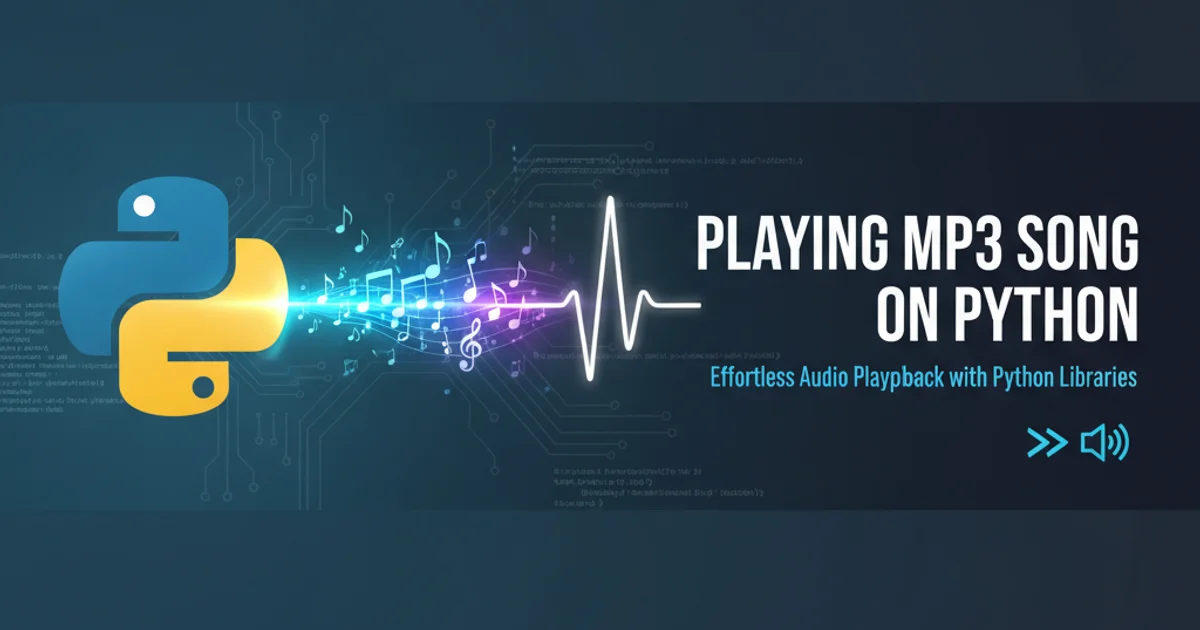Playing mp3 song on python
Categories:
Playing MP3 Songs in Python: A Comprehensive Guide

Learn how to integrate audio playback into your Python applications using popular libraries like pygame and playsound.
Python, with its vast ecosystem of libraries, offers several ways to play MP3 audio files. Whether you're building a simple script, a game, or a multimedia application, understanding the different approaches and their trade-offs is crucial. This article will guide you through the most common and effective methods, focusing on ease of use and practical implementation.
Choosing the Right Library
The best library for playing MP3s in Python depends on your project's specific needs. Some libraries offer extensive multimedia capabilities, while others are designed for simple, quick playback. We'll explore two popular choices: pygame for more control and playsound for simplicity.
flowchart TD
A[Start] --> B{"Need advanced audio control (e.g., mixing, events)?"}
B -- Yes --> C[Use Pygame Mixer]
B -- No --> D{"Need simple, blocking playback?"}
D -- Yes --> E[Use Playsound]
D -- No --> F[Consider other libraries (e.g., pydub, simpleaudio)]
C --> G[End]
E --> G[End]
F --> G[End]Decision flow for choosing a Python audio library
Method 1: Using Pygame Mixer
pygame is a popular library for game development in Python, and its mixer module provides robust functionalities for playing and manipulating audio. It's ideal for applications that require background music, sound effects, or more intricate audio control.
pygame, ensure you have it installed: pip install pygame.import pygame
import time
def play_mp3_pygame(file_path):
pygame.mixer.init()
pygame.mixer.music.load(file_path)
pygame.mixer.music.play()
# Keep the script running while the music plays
while pygame.mixer.music.get_busy():
time.sleep(1)
pygame.mixer.quit()
# Example usage:
# play_mp3_pygame("path/to/your/song.mp3")
Basic MP3 playback using pygame.mixer
Method 2: Using Playsound
The playsound library is designed for simplicity. It's a cross-platform module that plays a sound file with a single line of code. It's perfect for quick scripts or when you just need to play an audio file without complex controls.
playsound library is blocking by default, meaning your script will pause until the sound finishes playing. For non-blocking playback, you might need to run it in a separate thread.from playsound import playsound
def play_mp3_playsound(file_path):
playsound(file_path)
# Example usage:
# play_mp3_playsound("path/to/your/song.mp3")
Simple MP3 playback using playsound
Advanced Considerations and Troubleshooting
While the above methods cover basic playback, you might encounter scenarios requiring more advanced features or troubleshooting. For instance, handling different audio formats, controlling volume, pausing/resuming, or playing multiple sounds simultaneously. For these, pygame.mixer offers more granular control. Ensure your audio file paths are correct and that the necessary codecs are available on your system.
1. Install the library
Open your terminal or command prompt and install the chosen library using pip (e.g., pip install pygame or pip install playsound).
2. Prepare your MP3 file
Ensure you have an MP3 file available and note its full path. For testing, place it in the same directory as your Python script.
3. Write the Python code
Import the library and use the appropriate function to load and play your MP3 file, as demonstrated in the examples above.
4. Run your script
Execute your Python script from the terminal: python your_script_name.py. You should hear the MP3 playing.